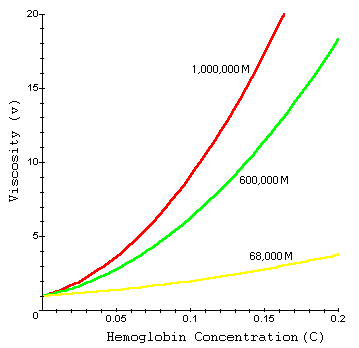
HEMOGLOBIN EVOLUTION
Introduction: Different species of animals can carry different types of hemoglobins in their blood. Animals such as oligachaetes have large molecular weight hemoglobins that are carried in the plasma. In contrast, other species, such as birds and mammals, have small molecular weight hemoglobins that are packaged in red blood cells.
Importance: Early biologists thought small hemoglobins evolved to increase the amount of oxygen transferred in the blood. High numbers of small hemoglobins, however, would likely increase the viscosity of the plasma. Red blood cells were thought to have evolved to package the small hemoglobins and prevent slower blood flow. We can use mathematical equations describing blood viscosity and oxygen transport to examine this theory for the evolution of red blood cells.
Question 1: Do large numbers of small molecular weight hemoglobins dramatically increase the viscosity of the blood?
Variables:
|
Q |
volume of oxygen transported per minute (cm3/min) |
|
C |
hemoglobin concentration (g%) |
|
v |
viscosity of blood (cm3/g) |
|
M |
molecular weight of hemoglobin |
|
r, s, a |
constants |
Methods: G. Snyder addressed questions about the evolution of red blood cells by using a simple equation. The volume of oxygen flowing per minute (Q) was assumed to be inversely proportional to blood viscosity (v) and directly proportional to hemoglobin concentration (C):

The viscosity (v) of blood is directly related to the molecular weight (M) and concentration (C) of hemoglobin by the following equation:

where s and a are constants.
Early biologists thought a high concentration of small hemoglobins would dramatically increase the viscosity of the blood. We can test this by plotting viscosity (v) as a function of molecular weight (M). Take s = 0.0238 and a = 0.5.

Interpretation: Notice that for small molecular weights (less than 70,000 M), viscosity does not increase dramatically with increasing hemoglobin concentration. Large hemoglobins (greater than 500,000 M) lead to a much higher and more dramatic increases in viscosity. This is contrary to early hypotheses about red blood cell evolution.
Question 2: Do smaller hemoglobins increase the supply of oxygen?
Methods: We can use some basic calculus on the function Q to find the maximum oxygen transport for different size hemoglobins. We find the maximum by differentiating the equation for oxygen transport (Q) with respect to hemoglobin concentration (C) and setting the derivative equal to zero. Remember to substitute the formula for viscosity (v) into the equation for Q.In fact, maximum oxygen transport occurs when

We can plot C as a function of M.

Interpretation: Early biologists hypothesized that small hemoglobins would have to be present in high concentrations in order to maximize oxygen transport. We can see from the above graph that this appears to be true. Hemoglobin concentration ne eded to maximize oxygen transport decreases as hemoglobin weight increases.
We can now plot our original function for oxygen transport (Q) as a function of C. Remember to substitute the formula for viscosity (v) into the equation for Q.

High concentrations of smaller hemoglobins lead to much higher levels of maximum oxygen transport than large hemoglobins.
Conclusions: Early biologist hypothesized that smaller hemoglobins likely evolved as more active organisms required higher levels of oxygen. This seems to be supported by equations quantifying oxygen transport. High concentrations of small hemoglobins do increase oxygen transport.
Contrary to early hypothesis, though, high concentrations of small hemoglobins do not dramatically increase viscosity. Red blood cells, then, apparently did not evolve to reduce blood viscosity. Instead, red blood cells may have coevolved with small hemoglobins as packaging to prevent them from being lost in excretory filters.
Additional Questions:
1. If you have had a calculus class, use the quotient rule to find dQ/dC. Remember to substitute the formula for viscosity (v) into the equation for Q.
Sources: Snyder, G. K. 1976. Blood corpuscles and blood hemoglobins: A possible example of coevolution. Science 195:412-413
Hainsworth, F. R. Animal Physiology: Adaptations in Function. 1981. Addison-Wesley Publishing Company, Inc., Reading, Massachusetts
Copyright 1999 M. Beals, L. Gross, S. Harrell